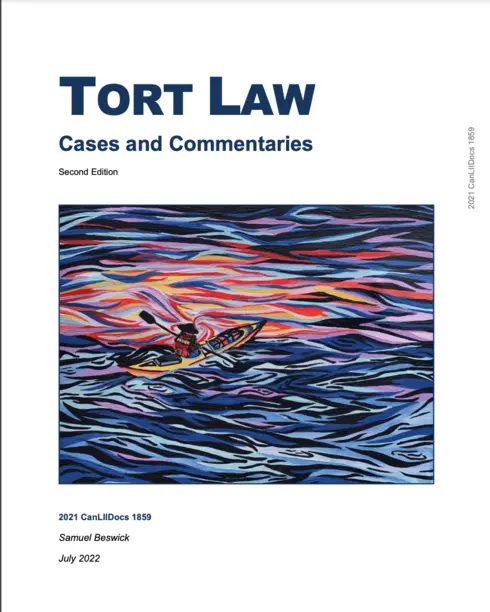
Tort Law: Cases and Commentaries - 2nd Edition
No ratings
Samuel Beswick, Vancouver, BC, Canada
Copyright Year:
Publisher: CanLII: Canadian Legal Information Institute
Language: English
Formats Available
Conditions of Use
![]() Attribution-ShareAlike
Attribution-ShareAlike
CC BY-SA
Table of Contents
- 1. Introduction
- 2. Trespass to the Person
- 3. Intentional Infliction of Mental Suffering
- 4. Invasion of Privacy
- 5. Defamation and Harassment
- 6. Defences
- 7. Intentional Interference with Real Property
- 8. Intentional Interference with Chattels
- 9. Remedies (I)
- 10. Tort Theory
- 11. Examination Questions (I)
- 12. No-fault Compensation schemes
- 13. Negligence: (i) Duty of Care
- 14. Negligence: (ii) Breach of Duty of Care
- 15. Negligence: (iii) Damage
- 16. Negligence: (iv) Causation of Damage in Fact
- 17. Negligence: (v) Remoteness of Damage in Law
- 18. Defences (II)
- 19. Difficult Categories of Negligence
- 20. Remedies (II)
- 21. Nuisance
- 22. Strict Liability Torts
- 23. Vicarious Liability
- 24. Tort Law and Legal Systems
- 25. Examination Questions (II)
- Index of Cases
About the Book
The law of obligations concerns the legal rights and duties owed between people. Three primary categories make up the common law of obligations: tort, contract, and unjust enrichment. This casebook provides an introduction to tort law: the law that recognises and responds to civil wrongdoing. The material is arranged in two parts. Part I comprises §§1-11 and addresses intentional and dignitary torts and the overarching theories and goals of tort law. Part II comprises §§12-25 and addresses no-fault compensation schemes, negligence, nuisance, strict liability, and tort law’s place within our broader legal systems.
This casebook was compiled and edited by Assistant Professor Samuel Beswick of the University of British Columbia Peter A. Allard School of Law. Maddison Zapach (J.D. expected 2023) provided research assistance on the first edition (published July 2021). We gratefully acknowledge the influence on our approach to this subject of Professor Joost Blom QC of the Allard School of Law, Professor John C.P. Goldberg of Harvard Law School, and Associate Professor Rosemary Tobin of the University of Auckland Faculty of Law. The support of Open UBC and the UBC Teaching and Learning Enhancement Fund is also gratefully acknowledged.
About the Contributors
Author
Samuel Beswick, University of British Columbia Peter A. Allard School of Law
